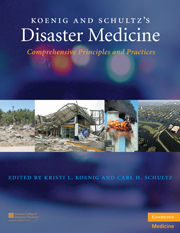Book contents
- Frontmatter
- Contents
- List of Contributors
- Contributor Biographies
- Foreword
- Preface
- Acknowledgments
- PART I CONCEPTUAL FRAMEWORK AND STRATEGIC OVERVIEW
- PART II OPERATIONAL ISSUES
- 9 Public Health and Emergency Management Systems
- 10 Legislative Authorities and Regulatory Issues
- 11 Syndromic Surveillance
- 12 Triage
- 13 Personal Protective Equipment
- 14 Decontamination
- 15 Quarantine
- 16 Mass Dispensing of Antibiotics and Vaccines
- 17 Management of Mass Gatherings
- 18 Transportation Disasters
- 19 Emergency Medical Services Scene Management
- 20 Healthcare Facility Disaster Management
- 21 Mass Fatality Management
- 22 Crisis and Emergency Risk Communication
- 23 Telemedicine and Telehealth Role in Public Health Emergencies
- 24 Complex Public Health Emergencies
- 25 Patient Identification and Tracking
- PART III CLINICAL MANAGEMENT
- Index
- Plate section
- References
15 - Quarantine
from PART II - OPERATIONAL ISSUES
Published online by Cambridge University Press: 05 August 2011
- Frontmatter
- Contents
- List of Contributors
- Contributor Biographies
- Foreword
- Preface
- Acknowledgments
- PART I CONCEPTUAL FRAMEWORK AND STRATEGIC OVERVIEW
- PART II OPERATIONAL ISSUES
- 9 Public Health and Emergency Management Systems
- 10 Legislative Authorities and Regulatory Issues
- 11 Syndromic Surveillance
- 12 Triage
- 13 Personal Protective Equipment
- 14 Decontamination
- 15 Quarantine
- 16 Mass Dispensing of Antibiotics and Vaccines
- 17 Management of Mass Gatherings
- 18 Transportation Disasters
- 19 Emergency Medical Services Scene Management
- 20 Healthcare Facility Disaster Management
- 21 Mass Fatality Management
- 22 Crisis and Emergency Risk Communication
- 23 Telemedicine and Telehealth Role in Public Health Emergencies
- 24 Complex Public Health Emergencies
- 25 Patient Identification and Tracking
- PART III CLINICAL MANAGEMENT
- Index
- Plate section
- References
Summary
OVERVIEW
Quarantine has been used for centuries to sequester potentially infectious individuals, plants, and animals until they are deemed safe for reintroduction to the rest of society. Criteria for the use of quarantine have often been subjective or based on discriminatory practice; individuals and entire communities were often cast from society and denied access to essential services. Crude efforts have been largely ineffective. Definitive protocols on time and distance necessary to contain the disease are often missing, and the efficacy of differing levels of separation is not well documented. The legal authority to quarantine exists within many jurisdictions worldwide, under many state laws in the U.S. Clear and convincing evidence to support the action is, however, frequently difficult to establish, creating significant concerns over civil liberties. When quarantine is instituted, enforcement poses significant challenges. In addition, there are limited effective plans on how to provide or pay for the secondary effects of quarantine: lost wages, impact on business and services, and logistical support such as food, water, and medical services for those individuals in confinement.
The overall objective of quarantine is to prevent the introduction, transmission, and spread of communicable diseases. The World Health Organization (WHO) has determined that crude methods of quarantine are ineffective. Current guidelines diverge from quarantine and predetermined measures concentrated at borders alone to containment strategies focused on real-time epidemiology and evidence-based data.
Keywords
- Type
- Chapter
- Information
- Koenig and Schultz's Disaster MedicineComprehensive Principles and Practices, pp. 203 - 212Publisher: Cambridge University PressPrint publication year: 2009



